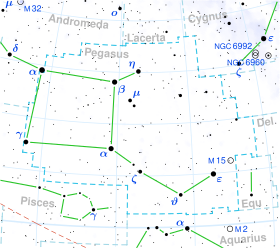페가수스 로
Rho Pegasi| 관측 데이터 에폭 J2000 이쿼녹스 J2000 | |
|---|---|
| 별자리 | 페가수스 |
| 우측 상승 | 22h 55m 13.66706s[1] |
| 탈위임 | 8° 48′ 58.2387″[1] |
| 겉보기 크기 (V) | 4.90[2] |
| 특성. | |
| 스펙트럼형 | A1V[3] |
| U-B색지수 | +0.00[2] |
| B-V색지수 | +0.00[2] |
| 아스트로메트리 | |
| 방사 속도 (Rv) | -10.6±0.9km[4]/s |
| 고유 운동 (μ) | RA: +80.168mas[1]/yr Dec.: +13.282[1]mas/yr |
| 시차 (π) | 11.9131 ± 0.2232[1] 마스 |
| 거리 | 274 ± 5 리 (84 ± 2pc) |
| 절대치수 (MV) | +0.01[5] |
| 세부 사항 | |
| 미사 | 2.84[6] M☉ |
| 반지름 | 3.1[7] R☉ |
| 루미도 | 110[6] L☉ |
| 표면 중력 (log g) | 3.90[8] cgs |
| 온도 | 9,484[6] K |
| 회전 속도 (v sin i) | 초속 107km[6] |
| 나이 | 331[8] 마이어 |
| 기타 지정 | |
| 데이터베이스 참조 | |
| 심바드 | 자료 |
ρ 페가수스에서 라틴어로 표기된 로 페가수스자리(Rho Pegasi)는 피스체와의 남쪽 별자리 경계 부근인 페가수스 북쪽 별자리에 있는 별이다.이것은 가시성 요소의 적절한 움직임의 변경에 의해 결정되는 개연성 있는 점성계 2진법이다.[10]흰색 빛깔을 띠며 육안으로는 4.90의 외관상으로 희미하게 보인다.[2]이 시스템은 시차(parallax)를 기준으로 태양으로부터 [1]약 274광년 거리에 위치하지만 방사상 속도 -10.6km/s로 더 가까이 표류하고 있다.[4]
이 가시성 성분은 A형 주계열성으로 별 분류는 A1V이다.[3]이 별은 3억 3천[8] 1백만 년 된 것으로, 107 km/s의 예상 회전 속도로 돌고 있다.[6]태양의 2.8배[6], 태양의 반경 3.1배의 질량을 가지고[7] 있다.이 별은 유효 온도 9,484 K로 광권으로부터 태양의 110배[6] 광도를 방사하고 있다.[6]
참조
- ^ a b c d e f Brown, A. G. A.; et al. (Gaia collaboration) (August 2018). "Gaia Data Release 2: Summary of the contents and survey properties". Astronomy & Astrophysics. 616. A1. arXiv:1804.09365. Bibcode:2018A&A...616A...1G. doi:10.1051/0004-6361/201833051.이 소스에 대한 가이아 DR2 기록 VizieR.
- ^ a b c d Ducati, J. R. (2002). "VizieR Online Data Catalog: Catalogue of Stellar Photometry in Johnson's 11-color system". CDS/ADC Collection of Electronic Catalogues. 2237. Bibcode:2002yCat.2237....0D.
- ^ a b Cowley, A.; et al. (April 1969), "A study of the bright A stars. I. A catalogue of spectral classifications", Astronomical Journal, 74: 375–406, Bibcode:1969AJ.....74..375C, doi:10.1086/110819
- ^ a b Gontcharov, G. A. (2006). "Pulkovo Compilation of Radial Velocities for 35 495 Hipparcos stars in a common system". Astronomy Letters. 32 (11): 759–771. arXiv:1606.08053. Bibcode:2006AstL...32..759G. doi:10.1134/S1063773706110065. S2CID 119231169.
- ^ Anderson, E.; Francis, Ch. (2012). "XHIP: An extended hipparcos compilation". Astronomy Letters. 38 (5): 331. arXiv:1108.4971. Bibcode:2012AstL...38..331A. doi:10.1134/S1063773712050015. S2CID 119257644. Vizier 카탈로그 항목
- ^ a b c d e f g h Zorec, J.; Royer, F. (2012). "Rotational velocities of A-type stars". Astronomy & Astrophysics. 537: A120. arXiv:1201.2052. Bibcode:2012A&A...537A.120Z. doi:10.1051/0004-6361/201117691. S2CID 55586789. Vizier 카탈로그 항목
- ^ a b Allende Prieto, C.; Lambert, D. L. (1999). "Fundamental parameters of nearby stars from the comparison with evolutionary calculations: Masses, radii and effective temperatures". Astronomy and Astrophysics. 352: 555–562. arXiv:astro-ph/9911002. Bibcode:1999A&A...352..555A. Vizier 카탈로그 항목
- ^ a b c David, Trevor J.; Hillenbrand, Lynne A. (2015). "The Ages of Early-Type Stars: Strömgren Photometric Methods Calibrated, Validated, Tested, and Applied to Hosts and Prospective Hosts of Directly Imaged Exoplanets". The Astrophysical Journal. 804 (2): 146. arXiv:1501.03154. Bibcode:2015ApJ...804..146D. doi:10.1088/0004-637X/804/2/146. S2CID 33401607. Vizier 카탈로그 항목
- ^ "rho Peg". SIMBAD. Centre de données astronomiques de Strasbourg. Retrieved 2019-10-16.
- ^ Eggleton, P. P.; Tokovinin, A. A. (September 2008), "A catalogue of multiplicity among bright stellar systems", Monthly Notices of the Royal Astronomical Society, 389 (2): 869–879, arXiv:0806.2878, Bibcode:2008MNRAS.389..869E, doi:10.1111/j.1365-2966.2008.13596.x, S2CID 14878976.



